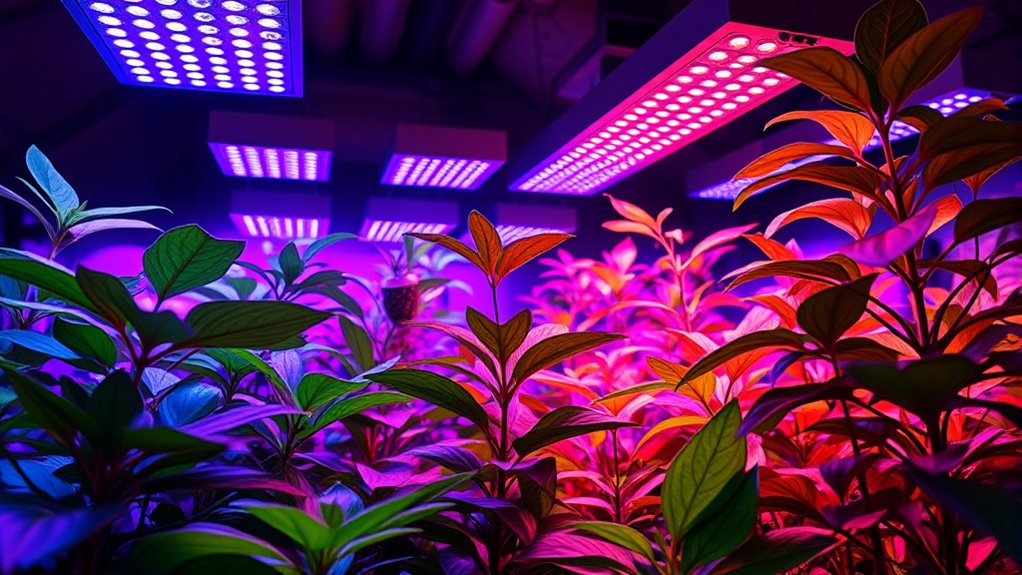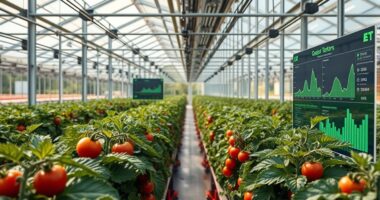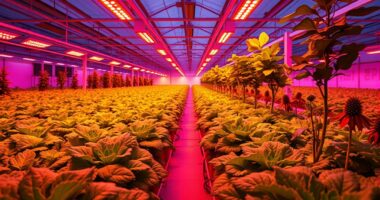Customizing spectra with LED grow lights lets you tailor the light conditions to each plant’s growth stage, boosting health and yields. By adjusting wavelengths like blue and red, you can optimize photosynthesis and development. These lights are energy-efficient, saving you money, and often come with customizable features like dimming and spectrum control. If you want to learn how to use these features effectively, you’ll find more details that can help you grow healthier plants.
Key Takeaways
- Customizable spectra allow tailoring light wavelengths to support specific plant growth stages, enhancing development and health.
- Full-spectrum LED grow lights enable precise emission of blue, red, and other wavelengths for optimal photosynthesis.
- Spectrum adjustment features, including dimming, help optimize light conditions for various plant varieties.
- Technological advances facilitate automated control of spectra, improving consistency and reducing manual management.
- Spectrum customization boosts growth efficiency, reduces energy consumption, and supports sustainable indoor gardening practices.

Are LED grow lights the right choice for your indoor gardening needs? If you’re aiming to enhance plant growth while keeping energy costs low, LEDs might be just what you’re looking for. One of their biggest advantages is the ability to customize the light spectrum, which directly influences how your plants develop. By adjusting the spectrum, you can target specific growth stages, like vegetative growth or flowering, ensuring your plants receive exactly what they need at each phase. Unlike traditional lighting options, LED grow lights can emit specific wavelengths, such as blue or red light, which are most beneficial for photosynthesis. This tailored approach helps maximize growth potential and can lead to healthier, more vigorous plants.
LED grow lights let you customize light spectra to boost plant growth at every stage.
Another major benefit is energy efficiency. LED technology consumes considerably less electricity compared to high-pressure sodium or metal halide lamps, translating to lower energy bills and reduced environmental impact. Because LEDs convert more electrical energy into usable light and waste less as heat, you can operate them at lower wattages without sacrificing intensity. This efficiency means your indoor garden gets the right amount of light without wasting power, making LEDs a cost-effective long-term investment. Plus, reduced heat output lessens the need for extensive cooling systems, saving you even more energy and setup costs.
When selecting LED grow lights, pay attention to the light spectrum they offer. A full-spectrum LED provides a balanced blend of wavelengths that can support all stages of plant development. Some models allow you to customize the spectrum further, giving you control over the specific light qualities your plants receive. This flexibility is especially valuable if you’re growing a variety of plants or want to fine-tune conditions for ideal growth. Many modern LED systems also include dimming features, so you can adjust light intensity as needed, preventing overstimulation or stress on your plants.
Additionally, advances in robotics integration are beginning to influence how indoor gardening systems are managed, potentially offering automated adjustments to light spectra and timing for optimal plant health. In essence, choosing LED grow lights means you’re investing in a versatile, energy-efficient solution tailored to your gardening goals. Their ability to customize the light spectrum ensures your plants get the precise wavelengths they need at every stage, boosting growth rates and health. Furthermore, their energy efficiency not only saves you money but also reduces your ecological footprint. As you plan your indoor garden, consider these factors carefully—LED grow lights offer a strategic advantage, helping you cultivate a thriving, sustainable indoor oasis.
Frequently Asked Questions
How Do Different Spectra Affect Plant Flowering Stages?
Different spectra considerably influence plant flowering stages by affecting chlorophyll absorption and photoperiod regulation. You’ll notice that red light promotes flowering by stimulating photoperiod-sensitive responses, while blue light supports vegetative growth. A balanced spectrum guarantees ideal chlorophyll absorption, boosting flowering. By adjusting the light spectrum, you help your plants regulate their photoperiods effectively, encouraging healthy, abundant blooms and overall better flowering performance.
Can Customized Spectra Improve Plant Nutrient Uptake?
Yes, customized spectra can improve your plant’s nutrient uptake by boosting photosynthesis efficiency. When you tailor light spectra to match your plants’ needs, you enhance chlorophyll absorption, which in turn increases nutrient absorption. This targeted approach helps your plants grow stronger and healthier by optimizing energy use and nutrient utilization, leading to better yields and overall plant performance.
Are Specific LED Wavelengths Better for Pest Resistance?
Yes, specific LED wavelengths can enhance pest resistance through spectrum selection. By choosing wavelengths that act as pest deterrent strategies, you make plants less attractive or detectable to pests. For instance, certain blue or UV spectra can repel insects or disrupt their behavior. Incorporating these targeted wavelengths into your grow lights can help protect your plants naturally, reducing the need for chemical pest control and promoting healthier growth.
How Does Light Spectrum Influence Plant Aroma and Flavor?
Sure, because who doesn’t want their plants to smell like a bakery or taste like a gourmet feast? You see, the light spectrum directly influences aroma enhancement and flavor development. By adjusting wavelengths, you can make your plants produce more aromatic oils or richer flavors. So, next time you pick your grow lights, remember, a tailored spectrum isn’t just about growth—it’s about turning your garden into a sensory paradise.
What Are the Energy Costs of Spectrum Customization?
Customizing spectra can increase your LED grow light’s energy consumption, impacting overall cost efficiency. While adding specific wavelengths may boost plant health and yield, it often requires more power, raising your electricity costs. To balance benefits and expenses, monitor your energy use closely and opt for spectrum adjustments that maximize plant growth without substantially raising energy consumption. This way, you maintain cost efficiency while optimizing plant results.
Conclusion
By customizing your LED grow lights’ spectra, you give your plants the exact light they need to thrive. Remember, “a little knowledge is a dangerous thing,” so understanding your plants’ specific needs can make all the difference. With the right spectrum adjustments, you’ll see healthier growth and better yields. Keep learning and experimenting—your green thumb will thank you, and success is just a spectrum away.









